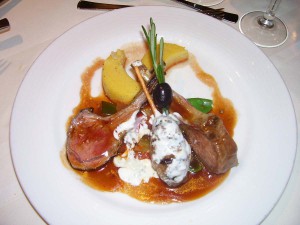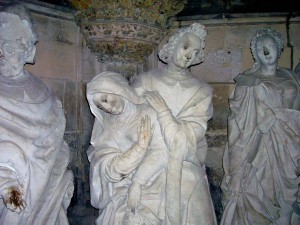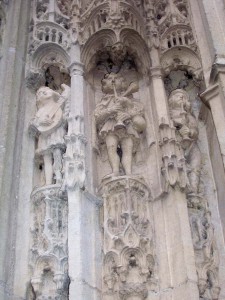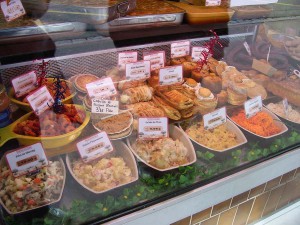FROM PARIS TO NORMANDY ON THE SEINE – THE SMALL TOWN OF CAUDEBEC
FROM PARIS TO NORMANDY ON THE SEINE
This is the eighth in a series of articles about cruising on the Seine
THE SMALL TOWN OF CAUDEBEC
By Charles N. Stevens
Photos by Dolores Seidman
Before dawn our ship leaves Rouen for Caudebec, a small town that I had never heard of. We arrive at eight in the morning wrapped in a dense fog. Later, as the fog lifts, the river still steaming, the town presents a hazy vision of itself, like stage curtains parting to reveal the setting of a scene. Old four-story buildings of standard French architecture line its main street.
In the misty morning we begin a walking tour of the town, the ground still wet from fog and dew. We pass a vigorous stream that bisects the town and empties into the Seine. Looking forlorn and neglected in the Seine is the old ferry that used to shuttle people and cars across the river. With the building of a new bridge, the ferry became obsolete. But it was so much a part of the town at one time that they can’t bear to part with it.
We walk down a path strewn with wet fallen leaves. The tide is out and much of the banks are exposed as glistening gray mud and rocks, seagulls resting on them.
The water is murky, almost muddy. The old brick Town Hall, now used as a river maritime museum, is the first building on our tour. It houses some of the early Seine boats and barges, the latter often hauling lumber.
Nearby is a house actually lived in by Victor Hugo. His daughter Leopoldine, married only six months, drowned in an accident on the Seine near here, a tragedy that so saddened him he gave up the house.
Caudebec was 80% destroyed in 1940 when the Germans, attempting to bomb the ferry, hit cars close to it. These burst into flame, the ensuing fire spreading to the other cars waiting in line and eventually the town. Most of the medieval half-timbered houses were lost.
At least the 13th century church survived although its stone exterior is still pocked with shrapnel scars and bullet holes. Its façade was also damaged during religious strife, the small stone figurines of saints around its entrance decapitated. It is a gothic church like many others we have seen. The stained glass windows are much brighter than in others, allowing much more light to enter the sanctuary, cheering it up somewhat. It is interesting too that the architect of the church, at his request, is buried beneath a slab in the floor. Traces of red and blue paint that once covered the stone columns and arches inside can barely be seen. This is the first time I have been aware that medieval churches were always painted inside and were not the cold, dreary stone interiors that we see today.
Farther in town we listen to the splash and murmur of the stream as it passes through. Green plants grow on its bottom and stream out in the swift current. We pass another building of the 14th century, gothic and stained stone, once housing the Knights Templars. Nearby a man carries a baguette by the middle, another carrying his as he slips into his car. Bakeries turn out hundreds of them a day.
But what I like to do most of all is look into the windows of the food shops. We pause in front of a charcuterie window gazing at the cooked meats and the colorful pans of prepared food, all dazzling the eye, tempting the palate. We move on to a boulangerie with its attractive displays of cuts of meat.
The clouds begin to break up, and the sun tries to bore through, but without much success. Visibility is much better now, allowing us to see the wooded hills and the new suspension bridge that made the ferry obsolete.
We look into the windows of a photographer, his best photos displayed. The photographs are quite unusual, so different that Americans might not like them. One shows a bride and groom in their Inflatable Water Slide wedding attire at a beach walking in the surf. Another depicts a man kissing the pregnant belly of his wife. Still another is of a child with her ear against her mother’s swollen belly, listening to the heartbeat of the unborn child. I had never seen anything like them before, gathering they were celebrations of pregnancy and new life.
We walk by shops selling kitchen utensils and a cinema showing a film about the French resistance during wartime. A man steps out of a patisserie with an armful of baguettes. There are dress shops with fashionable clothing, colorful flower shops and a chocolatier offering mouth watering chocolate creations. Next is a beauty shop offering a shampoo and brushing for 30 Euros, followed by a boucherie offering plump white sausages. Outdoor cafes abound. We pass the empty market stalls and shelters and tarry at their modern library where Dolores e-mails the folks at home.
We note too that French men and women tend to drive fast, even when people are close by. In their favor, they respect crosswalks, always stopping to let pedestrians walk across the street. We see a little girl in a stroller with light blond hair and pale blue eyes. Her brother who runs his bike into me has the same features. I can’t help but think that they represent the Viking heritage once so established in this area.
Back at our ship now, I watch two sea-going ships pass up the Seine, probably on their way to Rouen.
I find a fragment of a poem written in 1829 by Arthur Henry Hallam:
But for quiet joy of nature’s own,
To warm the heart again,
Give me Caudebec and Mailleraie,
On the pleasant banks of Seine.

Meals are not only tasty on the ship but beautiful to see as well.

Some of the old statuary in the Caudebec Church

Delicate statuary on the outside of the church

Looking at the food displays in a typical charcuterie would make anyone hungry.
.



